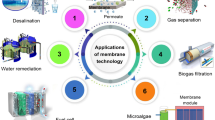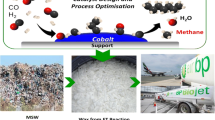Abstract
Direct determination of the process deactivation model relates to catalyst stability and plays a crucial role in the process control. The present study aims at investigating the influence of nickel loading (10–20 wt%) on the deactivation model parameters of Ni/Al2O3 catalyst prepared by incipient wetness impregnation. Artificial neural network (ANN) predicts a steady-state activity of the catalyst for the ultimate purpose of a deactivation model selection. The results obtained from an ANN demonstrated that the first-order general power law expressions (GPLE1 model) could adequately predict the catalytic activity during long reaction time. Considering various loadings of nickel on an alumina support, better stability of 20Ni/Al2O3 catalyst was confirmed. Model parameters affirmed that a decrease in the loading of the nickel-made active phase increases the deactivation rate of the catalyst.
Graphic Abstract








Similar content being viewed by others
References
Zohdi-Fasaei H, Atashi H, Farshchi Tabrizi F, Mirzaei AA (2017) Modeling and optimization of Fischer-Tropsch synthesis over Co–Mn–Ce/SiO2 catalyst using hybrid RSM/LHHW approaches. Energy 128:496–508
Mosayebi A, Abedini R (2017) Detailed kinetic study of Fischer-Tropsch synthesis for gasoline production over CoNi/HZSM-5 nano-structure catalyst. Int J Hydrog Energy. 42(44):27013–27023
Li C, Sayaka I, Chisato F, Fujimoto K (2016) Development of high performance graphite-supported iron catalyst for Fischer-Tropsch synthesis. Appl Catal A 509:123–129
Zhao J, Zhao B, Wang X, Yang X (2017) Atomization performance and TG analysis of Fischer-Tropsch fuel compared with RP-3 aviation fuel. Int J Hydrog Energy 42(29):18626–18632
Zhang L, Chu H, Qu H, Zhang Q, Xu H, Cao J et al (2018) An investigation of efficient microstructured reactor with monolith Co/anodic γ-Al2O3/Al catalyst in Fischer-Tropsch synthesis. Int J Hydrog Energy 43(6):3077–3086
Khodakov AY, Chu W, Fongarland P (2007) Advances in the development of novel cobalt Fischer-Tropsch catalysts for synthesis of long-chain hydrocarbons and clean fuels. Chem Rev 107(5):1692–1744
Casci JL, Lok CM, Shannon MD (2009) Fischer-Tropsch catalysis: the basis for an emerging industry with origins in the early 20th century. Catal Today 145(1–2):38–44
Bartholomew CH (2001) Mechanisms of catalyst deactivation. Appl Catal A 212(1–2):17–60
Mattos LV, Jacobs G, Davis BH, Noronha FB (2012) Production of hydrogen from ethanol: review of reaction mechanism and catalyst deactivation. Chem Rev 112(7):4094–4123
Rojo-Gama D, Signorile M, Bonino F, Bordiga S, Olsbye U, Lillerud KP et al (2017) Structure-deactivation relationships in zeolites during the methanol-to-hydrocarbons reaction: complementary assessments of the coke content. J Catal 351:33–48
Steynberg AP, Deshmukh SR, Robota HJ (2018) Fischer-Tropsch catalyst deactivation in commercial microchannel reactor operation. Catal Today 299:10–13
Jahangiri H, Bennett J, Mahjoubi P, Wilson K, Gu S (2014) A review of advanced catalyst development for Fischer-Tropsch synthesis of hydrocarbons from biomass derived syn-gas. Catal Sci Technol 4(8):2210–2229
Li D, Koike M, Wang L, Nakagawa Y, Xu Y, Tomishige K (2014) Regenerability of hydrotalcite-derived nicke-iron alloy nanoparticles for syngas production from biomass tar. chemSusChem 7(2):510–522
Chen SQ, Liu Y (2009) LaFeyNi1−yO3 supported nickel catalysts used for steam reforming of ethanol. Int J Hydrog Energy 34(11):4735–4746
Ashok J, Kawi S (2013) Nickel–iron alloy supported over iron–alumina catalysts for steam reforming of biomass tar model compound. ACS Catal 4(1):289–301
Zhang T, Amiridis MD (1998) Hydrogen production via the direct cracking of methane over silica-supported nickel catalysts. Appl Catal A 167(2):161–172
Suelves I, Lázaro MJ, Moliner R, Corbella BM, Palacios JM (2005) Hydrogen production by thermo catalytic decomposition of methane on Ni-based catalysts: influence of operating conditions on catalyst deactivation and carbon characteristics. Int J Hydrog Energy 30(15):1555–1567
Tao M, Meng X, Lv Y, Bian Z, Xin Z (2015) Effect of impregnation solvent on Ni dispersion and catalytic properties of Ni/SBA-15 for CO methanation reaction. Fuel 165:289–297
van de Loosdrecht J, van der Kraan AM, van Dillen AJ, Geus JW (1996) Metal-support interaction: titania-supported nickel-iron catalysts. Catal Lett 41(1):27–34
Adib H, Haghbakhsh R, Saidi M, Takassi MA, Sharifi F, Koolivand M et al (2013) Modeling and optimization of Fischer-Tropsch synthesis in the presence of Co(III)/Al2O3 catalyst using artificial neural networks and genetic algorithm. J Nat Gas Sci Eng 10:14–24
Shiva M, Atashi H, Tabrizi FF, Mirzaei AA, Zare A (2013) The application of hybrid DOE/ANN methodology in lumped kinetic modeling of Fischer-Tropsch reaction. Fuel Process Technol 106:631–640
Khorashadizadeh M, Atashi H, Mirzaei AA (2017) Process conditions effects on Fischer-Tropsch product selectivity: modeling and optimization through a time and cost-efficient scenario using a limited data size. J Taiwan Inst Chem Eng 80:709–719
Barrientos J, Lualdi M, Boutonnet M, Järås S (2017) Deactivation of supported nickel catalysts during CO methanation. Appl Catal A 486:143–149
Acknowledgments
This research is financially supported by the University of Sistan and Baluchestan. The authors particularly thank the University of Sistan and Baluchestan.
Author information
Authors and Affiliations
Corresponding author
Ethics declarations
Conflict of interest
The authors declare that they have no conflict of interest.
Additional information
Publisher's Note
Springer Nature remains neutral with regard to jurisdictional claims in published maps and institutional affiliations.
Rights and permissions
About this article
Cite this article
Ghofran Pakdel, M., Zohdi-Fasaei, H., Mirzaei, A.A. et al. Neural Computing Strategy for Predicting Deactivation of Fischer–Tropsch Synthesis With Different Nickel Loadings. Catal Lett 149, 2444–2452 (2019). https://doi.org/10.1007/s10562-019-02860-1
Received:
Accepted:
Published:
Issue Date:
DOI: https://doi.org/10.1007/s10562-019-02860-1




